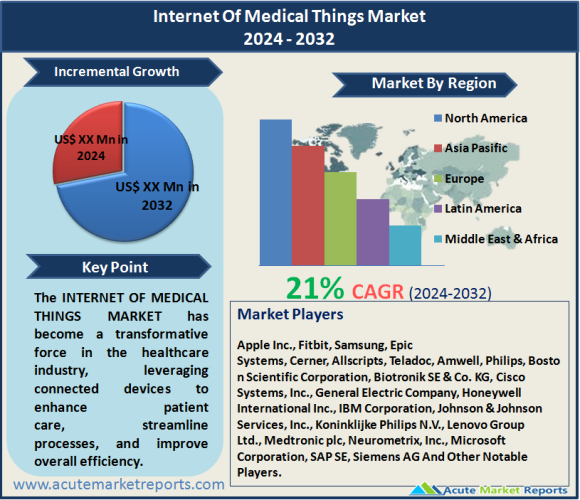
The Internet of medical things (IoMT) has become a transformative force in the healthcare industry, leveraging connected devices to enhance patient care, streamline processes, and improve overall efficiency. The Internet of medical things continues to reshape the healthcare landscape and is expected to grow at a CAGR of 21% during the forecast period of 2025 to 2033, driven by advancements in wearable technology, data interoperability, and the rise of telehealth. While data security remains a critical concern, the IoMT market is poised for significant growth, with services, cloud deployment, and the Asia-Pacific region emerging as key drivers. As industry giants pave the way for innovation, the IoMT's impact on healthcare delivery and patient outcomes is expected to intensify in the coming years.
Advancements in Wearable Technology
Wearable devices equipped with health-monitoring sensors have emerged as a cornerstone of IoMT. In 2024, companies like Apple, Fitbit, and Samsung demonstrated the potential of wearables in tracking vital signs, detecting anomalies, and promoting proactive healthcare. The integration of continuous glucose monitoring, ECG capabilities, and sleep tracking contributed to the widespread adoption of wearables, fostering a paradigm shift towards preventive healthcare.
Data Interoperability and Integration
The seamless exchange and integration of healthcare data across various systems and devices have been instrumental in propelling IoMT. Initiatives promoting interoperability, such as Fast Healthcare Interoperability Resources (FHIR), gained momentum in 2024. Healthcare providers and technology companies, including Epic Systems, Cerner, and Allscripts, collaborated to create an interconnected ecosystem, enhancing the accessibility and accuracy of patient information.

Rise of Telehealth and Remote Patient Monitoring
The global adoption of telehealth solutions and remote patient monitoring systems surged in 2024, driven by the need for accessible and efficient healthcare services. Companies like Teladoc, Amwell, and Philips played pivotal roles in expanding virtual care options. The integration of IoMT devices allowed healthcare professionals to remotely monitor patients' health conditions, enabling timely interventions and reducing the burden on traditional healthcare infrastructure.
Restraint
Despite the promising advancements, a key restraint in the IoMT landscape was the concern regarding data security and privacy. In 2024, instances of cyberattacks on healthcare networks and unauthorized access to patient data raised apprehensions among both healthcare providers and patients. The need for robust cybersecurity measures, as evidenced by breaches reported by organizations like HIMSS and the U.S. Department of Health and Human Services, underscored the critical importance of securing sensitive medical information.
Market Segmentation by Component – Software Segment Dominates the Market
The IoMT market can be segmented into hardware, software, and services. In 2024, the highest revenue was generated by the software segment, driven by the demand for data analytics, connectivity solutions, and interoperability platforms. However, during the forecast period of 2025 to 2033, the highest Compound Annual Growth Rate (CAGR) is expected in the services segment, emphasizing the increasing need for implementation, support, and maintenance services in the evolving IoMT landscape.
Market Segmentation by Deployment Outlook - On-premise Dominated the Market
The deployment outlook for IoMT includes on-premise and cloud solutions. In 2024, the on-premise deployment model dominated in terms of revenue, as healthcare organizations prioritized maintaining control over their data infrastructure. Nevertheless, the cloud deployment model is anticipated to exhibit the highest CAGR during the forecast period, reflecting the industry's shift towards flexible, scalable, and cost-effective cloud solutions.
North America Remains the Global Leader
Geographically, the IoMT market showcased diverse trends. In 2024, North America led in both revenue and CAGR, driven by robust investments in healthcare technology and infrastructure. However, the Asia-Pacific region is expected to experience the highest CAGR during the forecast period, indicating significant growth opportunities and increased adoption of IoMT solutions in emerging markets.
Market Competition to Intensify during the Forecast Period
Top players in the IoMT market include Apple Inc., Fitbit, Samsung, Epic Systems, Cerner, Allscripts, Teladoc, Amwell, Philips, Boston Scientific Corporation, Biotronik SE & Co. KG, Cisco Systems, Inc., General Electric Company, Honeywell International Inc., IBM Corporation, Johnson & Johnson Services, Inc., Koninklijke Philips N.V., Lenovo Group Ltd., Medtronic plc, Neurometrix, Inc., Microsoft Corporation, SAP SE, and Siemens AG. These companies employ diverse strategies, such as partnerships, acquisitions, and product innovations, to stay competitive. In 2024, their revenues reflected market leadership, with expectations of sustained growth during the forecast period.
Historical & Forecast Period
This study report represents analysis of each segment from 2023 to 2033 considering 2024 as the base year. Compounded Annual Growth Rate (CAGR) for each of the respective segments estimated for the forecast period of 2025 to 2033.
The current report comprises of quantitative market estimations for each micro market for every geographical region and qualitative market analysis such as micro and macro environment analysis, market trends, competitive intelligence, segment analysis, porters five force model, top winning strategies, top investment markets, emerging trends and technological analysis, case studies, strategic conclusions and recommendations and other key market insights.
Research Methodology
The complete research study was conducted in three phases, namely: secondary research, primary research, and expert panel review. key data point that enables the estimation of Internet Of Medical Things market are as follows:
Market forecast was performed through proprietary software that analyzes various qualitative and quantitative factors. Growth rate and CAGR were estimated through intensive secondary and primary research. Data triangulation across various data points provides accuracy across various analyzed market segments in the report. Application of both top down and bottom-up approach for validation of market estimation assures logical, methodical and mathematical consistency of the quantitative data.
| ATTRIBUTE | DETAILS |
|---|---|
| Research Period | 2023-2033 |
| Base Year | 2024 |
| Forecast Period | 2025-2033 |
| Historical Year | 2023 |
| Unit | USD Million |
| Segmentation | |
Component
| |
Deployment
| |
Application
| |
End-Use
| |
|
Region Segment (2023-2033; US$ Million)
|
Key questions answered in this report